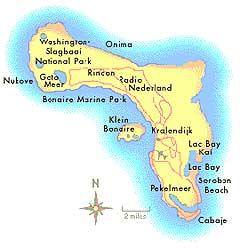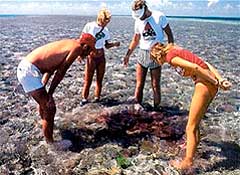
November 29, 2001
Bonaire: A Successful Marine Protected Area
By Lucy Gallagher-Freymuth
|
|
Bonaire is a 288 km² crescent shaped island located in the Caribbean Sea approximately 100 km north of the coast of Venezuela. It is one of the five islands that form the Netherlands Antilles: Bonaire, Curaçao, and the Windward Islands of St. Maarten, Saba, and St. Eustatius (Statia).
The resident population of Bonaire was estimated at 14,900 in 1998. The economy of Bonaire relies principally on tourism, particularly that related to scuba diving. In 1999, an estimated 70,000 tourists visited Bonaire, 29,500 of which were believed to be divers. Other industries include oil transference, salt production, and some light industry such as apparel manufacture and rice processing.
|
|
About 1 km off the west coast of Bonaire lies Klein Bonaire (Little Bonaire), an uninhabited islet of 600ha. Both Bonaire and Klein Bonaire are surrounded by continuous, fringing coral reefs from the shoreline seaward to depths in excess of 70m, covering an area of some 2,600 ha. The waters around these islands are officially protected as the Bonaire Marine Park, from the shoreline to a depth of 60m. According to Dixon et al (1991), the marine park generates direct revenue from park fees ($US 0.19 million) and indirect revenue from hotels, dive operations, restaurants and air transport (US$ 23.2 million).
|
Revenues and Costs Associated with Bonaire Marine Park (1991) |
|
|
Revenues |
US $ (millions) |
|
Direct Revenue |
|
|
Diver fees (1992 est.) |
0.19 |
|
Indirect (private sector) Revenue (gross) |
|
|
Hotels (rooms/meals) |
10.4 |
|
Dive operation (including retail sales) |
4.8 |
|
Restaurant, souvenir, car rental, misc. services |
4.7 |
|
Local air transport |
3.3 |
|
Subtotal |
23.2 |
|
Costs |
US $ (millions) |
|
Costs of Protection |
|
|
Direct costs - establishment, initial operation, rehabilitation |
0.52 |
|
Direct costs - annual recurring costs |
0.15 |
|
Indirect costs |
? |
|
Opportunity costs |
? |
|
Source: Dixon et al (2000) |
|
History of Bonaire Marine Park:
|
|
Bonaire Marine Park was established in the early 1980s with grant funding from the World Wildlife Fund, Holland together with matching funds from the Dutch and local governments. Although serious conservation work was carried out in the early days of the park's creation, by 1984 it had run out of funds. According to Dixon et al (1993), these financial problems resulted in a "decline of management effectiveness, resulting in a decreasing frequency of patrols, inadequate law enforcement, lack of information and educational activities, and discontinuity of research and monitoring". With no staff or funding, Bonaire Marine Park became a "paper park".
|
|
In the early 1990s, the Island Government of Bonaire, concerned with this lack of management and an increase in damaging coastal activities took a stance on the situation. Several recommendations were made, one of which was the introduction of a visitor fee. The implementation of this fee led the Dutch Government to approve funding and technical assistance for the revitalisation of the park for a period of three years. In 1991, a new park manager and consultant were appointed and, in 1992, the Bonaire government introduced a US$10.00 annual admission fee, payable by anyone scuba diving in the Marine Park.
By the end of 1992, the park had become entirely self-financing. This fee goes toward park upkeep and maintenance, law enforcement, information and education, and research and monitoring. Activities which have been essential in preventing the severe degradation of the Bonaire coastal area.
Tourism and Marine Protected Area
According to Roberts and Hawkins (2000), marine protected areas can be highly attractive to tourists. Indeed, the increased biodiversity that exists in protected areas are particularly appealing to divers and snorkellers. In return, tourism can provide a source of funding for marine protected areas. Bonaire Marine Park is a clear example of how tourism can finance a marine protected area.
|
|
However, it is important to also consider that tourism may also damage marine habitats. Trampling is one aspect of tourism which directly affects reef degradation. Extensive physical damage on coral can furthermore be caused by scuba divers and snorkellers. There is also indirect damage to coral reefs from tourism: the demand for fish in restaurants and for tourists' curios (shells, starfish, seahorses, etc.), for instance, often results in the overfishing and overharvesting of key reef species. In addition, tourist resorts and hotels often discharge sewage into the sea, polluting reef water and promoting algal growth.
In order to control the damage subjected to coral reef ecosystems, it is therefore important to ensure sustainable levels of tourism by monitoring and managing protected areas effectively.
Click here to visit the Coral Reef exhibit on the HORIZON Solutions Site
Lucy Gallagher-Freymuth is a HORIZON Intern. Later this month her case study on the island's coral reef preservation efforts will be posted. Lucy has worked as a volunteer on coral reef projects in Belize, Honduras and the Philippines and is aiming at a career in coral reef management. She is currently studying for an MSc in Environmental Assessment and Evaluation at the London School of Economics, UK.
(c) HORIZON INTERNATIONAL 2001




